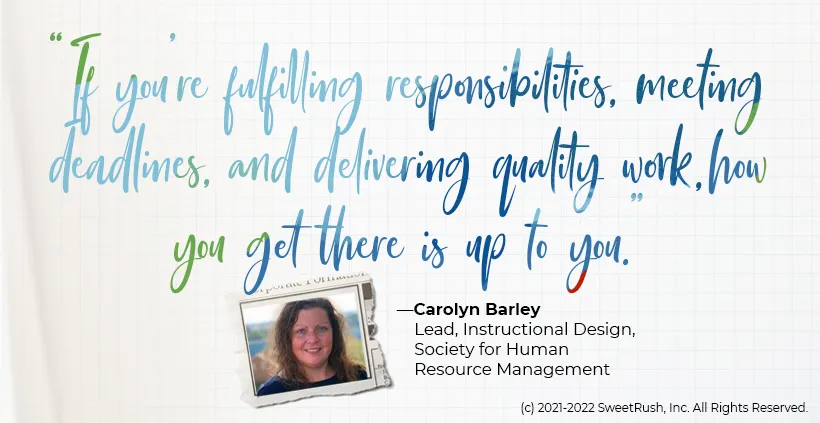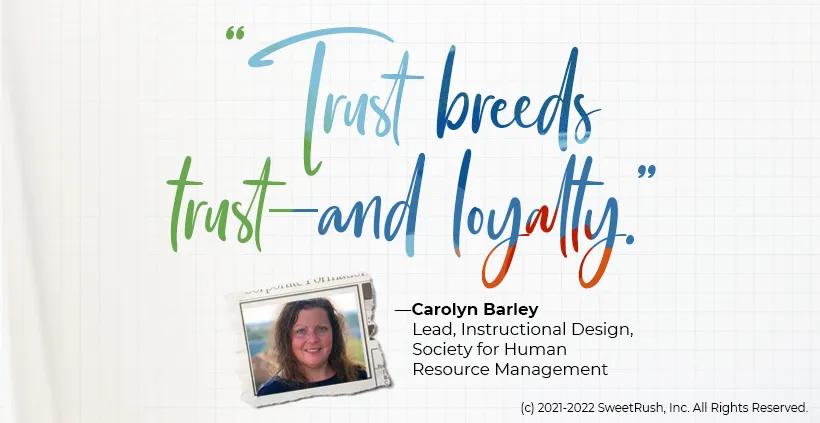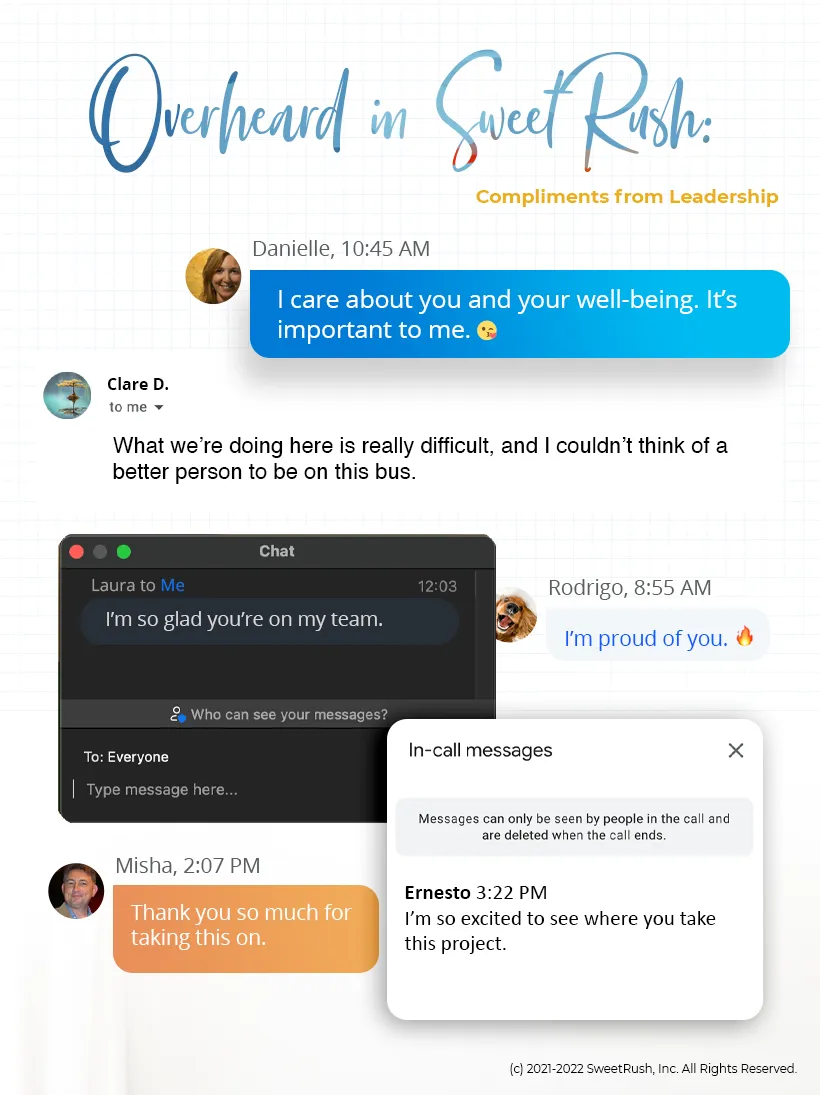
You’ve probably noticed that we’ve been in a bit of a crucible. We’re being tested by extreme weather and temperatures in some of our most cherished places, a global public health crisis, a global mental health crisis, a global economic crisis, social injustice and unrest, and an all-time high of economic inequity.
It’s tempting to tune out, but people and the planet are hurting. And so will our businesses, unless we seize the opportunity—and the responsibility—to drive social change.
The businesses that are best prepared to survive this crucible are the ones that live in the world responsibly. The ones that support humans and the planet with freedom and abundance. The ones that step up for their people when life knocks them down.
At SweetRush, we love to see our people living and working in a state of flow and abundance, and we strive to maintain that state as much as we can.1 But we realize how rare it can be in the world. Witness the millions of workers who have already heeded the carpe diem call to change jobs2,3—and the 40% who are still looking.4
What are these folks seeking? A workplace concerned with the “care and resilience of human workers”5 and “the big global we” beyond our immediate families, social networks, and teams.6
That’s called a human-centered organization—or, as we like to say, a life-centered business or organization.7 Human-centered and life-centered organizations don’t just offer a kinder, gentler employee experience; they also do markedly better business and leave the world better than they found it.
If you’re still with me, you’re likely convinced of the value of human-centered work and life. But you may still be wondering how to initiate—or build on—a transformation within your own team, department, or organization. Wherever you sit, these seven hallmarks will help you build a human-centered leadership practice.
Whatever their industry, and whatever their role, everyone wants to feel engaged and treated fairly.
That means treating our employees with the same care we want to receive from them or, in more transactional terms, giving as good as we get.
Human-centered leaders want to enjoy abundance and freedom from suffering, so they provide it to employees. They want grace when they make mistakes, so they show grace to others when they do the same. They want the space to practice their crafts and learn, so they provide that space for others. They want to receive empathy and support from others so—you guessed it!—they make a habit of showing empathy and support for their employees.
Because these actions come from leadership, they speak louder and stand taller. They also demonstrate that the Golden Rule is a yardstick used every day, at every level of the organization.
At SweetRush, we use the Golden Rule to decide:
That means turning away prospective partners when our values don’t align—and holding one another accountable for our words and actions.
These conversations can be tough! But sharing this fundamental value makes the tough stuff easier.

You might be one of the many leaders standing on the remote/hybrid/in-person workplace Rubicon (if these options are viable for your business) and wondering: Should we go back to the way we were?
If you ask us, we’d say an emphatic no. Remote work is the life-centered choice—and the best one for your business.
If you’re still thinking of remote work as a perk to be rationed sparingly, it’s time to update your mindset. Your employees have been doing their jobs (and then some) for over a year.
No one—not your team, your managers, or your clients—will benefit from reintroducing the daily commute. Taking it away has returned a valuable hour (or more!) to your employees every day. That’s an hour they spend being a human being instead of white-knuckling it on a highway—truly a great application of the Golden Rule.
Of course, remote doesn’t work for every position. Sometimes employees do need to show up and serve the guest or make the thing. Even for knowledge-based roles, remote work may not work all of the time. Some people need—and want!—a separate workspace.
How to make everyone happy? Give them a choice.
If you’re maintaining an office space, offer employees the opportunity to work there—at least once in a while. If you’re in a manufacturing or construction setting, offer employees as many choices as possible as to when and how they work.
If work sites, hours, and processes are written in stone, give employees autonomy around the type of recognition they receive. Sound frivolous? General Mills boosted the engagement and morale of its hard-working manufacturing team by offering employees three options for receiving their bonuses: cash, time off, or a charity donation.8 The amount was modest, but being offered a choice made employees feel valued and respected—and it started a lively internal conversation!
In short, let the Golden Rule be your guide. Your employees want the autonomy to manage their work and schedules, just as you do. They want as much choice as possible in when, where, and how they work. They’d love to be asked for their feedback on how to streamline procedures and processes—and listened to when they share. From the custodian to the C-suite, everyone thrives when they feel trusted and respected.


Like shoulder pads and smoking sections, cutthroat corporate culture needs to be a thing of the past. But with 75% of employees reporting a lack of empathy in their work environment, it’s clearly still alive and well.9
It’s never a weakness or an impediment to productivity to choose the most humane path—and doing so helps your employees share the wealth. When their needs are met, your employees have the bandwidth to extend grace and support to clients and colleagues who are going through a rough time.
Our CEO and Cofounder Andrei Hedstrom likens care at work to the “gravitational force” that holds people together in a committed relationship; it’s powerful, but it can be eroded. That’s why the human-centered organization should work to continually strengthen that force holding its people together.
I’ll keep this one short: Verbalizing care is an important step, especially in virtual work when cues like gestures and body language don’t come through. Getting verbal with employees is an important human-centered leadership practice: Strong and silent doesn’t work anymore.
Here are some examples of how care might sound (and read!).

Here’s the flip side of verbalizing. If someone offers you a compliment, take it! Even if you don’t agree that you’re funny, a great speaker, or amazing at Zoom karaoke, the added confidence just might boost your skills. That’s a hack straight from Cofounder and Human-Centered Leader Arturo Schwartzberg: He finds himself striving to deserve the compliment—and doing better in the process.
Human-centered leaders do a lot—and we tend to do it alone. But accepting the occasional offer of help can strengthen our relationship with our peers and employees. All humans feel richer when we can give to each other—even when we don’t have much to give. Ben Franklin observed that we like people more when we help them, and this feel-good effect has been confirmed by more recent psychological studies.10
Practice saying yes—it’s a win for everyone.
Showing and accepting care doesn’t mean we don’t engage in tough conversations; in fact, it enables them. That foundation of care has to be solid for radical candor11 to land.
When we gather, we share responsibility for what happens during our time together. That means being accountable for our words, actions, and commitments12—and this accountability isn’t just for SweetRush people. We also hold our clients accountable.
We want to partner with clients, which means delivering bad news along with the good, and negative feedback along with the positive. It’s hard for some clients to hear that they’re going out of scope or that they’re impeding the development process.
Radical candor is part of the SweetRush experience—and it’s part of what helped us weather the financial crisis of 2008 and 2009. Throughout that challenging time, we kept our clients updated. Even though the news was often hard to hear, they knew that they could trust us to meet revised deadlines and project scopes. That trust—and their grace in accepting what we could deliver after our best-laid plans changed—played a huge role in our survival.
Though our client list has grown, we still work with clients who share our values—and who are comfortable holding the tough conversations.
Whatever its industry, every human-centered organization is in the business of making lives better. You’ll probably want to narrow that mission down a bit to fit your business, but keep it aspirational and inspiring.
For example, SweetRush’s Big Hairy Audacious Goal is to positively impact the lives of a billion people through our craft. It is pretty audacious, but every project gets us closer. That’s a key part of human-centered work and leadership—working together in service of a meaningful cause.
Our human- and life-centered initiatives add another layer of purpose. For example, Good Things gives our teams the opportunity to practice their craft in the service of nonprofit organizations that perform vital work in education, human services, and the environment. Team members count their work on these projects among the most meaningful events of their lives—on par with meeting their life partner or child for the first time.
In spring 2021, we added to our shared mission with La Maestra, an initiative that offsets the carbon footprint of every project by planting trees in the Costa Rica rainforest. Both our team and our clients have rallied behind the opportunity to build a legacy with their work.
Offering employees (and clients!) the chance to share a larger mission might not be the most obvious application of the Golden Rule. But when we do so, we help folks with different beliefs, backgrounds, and politics gather around a cause that unifies rather than divides. Bridging those divisions is a wonderful example of living in the world responsibly—and leading by example.

You’ve gotten a sample of how human-centered leadership looks, sounds, and feels. And though beginning with the Golden Rule feels intuitive, implementing it at the organizational level can raise questions.
We hear you! That’s why we’ve created a toolkit for thinking about and evolving your own organization. Our eBook It’s All About Your People!: Embracing Human-Centered Business, Workplace Culture, and Learning Design offers a curated collection of the best mindsets and practices from our two decades together as a life-centered organization—and decade-plus as a fully remote team. We’ve got plenty of proven steps leaders like you can take today (or anytime!) to create a workplace that helps you, your people, and your business thrive.
You’ve probably noticed that we’ve been in a bit of a crucible. We’re being tested by extreme weather and temperatures in some of our most cherished places, a global public health crisis, a global mental health crisis, a global economic crisis, social injustice and unrest, and an all-time high of economic inequity.
It’s tempting to tune out, but people and the planet are hurting. And so will our businesses, unless we seize the opportunity—and the responsibility—to drive social change.
The businesses that are best prepared to survive this crucible are the ones that live in the world responsibly. The ones that support humans and the planet with freedom and abundance. The ones that step up for their people when life knocks them down.
At SweetRush, we love to see our people living and working in a state of flow and abundance, and we strive to maintain that state as much as we can.1 But we realize how rare it can be in the world. Witness the millions of workers who have already heeded the carpe diem call to change jobs2,3—and the 40% who are still looking.4
What are these folks seeking? A workplace concerned with the “care and resilience of human workers”5 and “the big global we” beyond our immediate families, social networks, and teams.6
That’s called a human-centered organization—or, as we like to say, a life-centered business or organization.7 Human-centered and life-centered organizations don’t just offer a kinder, gentler employee experience; they also do markedly better business and leave the world better than they found it.
If you’re still with me, you’re likely convinced of the value of human-centered work and life. But you may still be wondering how to initiate—or build on—a transformation within your own team, department, or organization. Wherever you sit, these seven hallmarks will help you build a human-centered leadership practice.
Whatever their industry, and whatever their role, everyone wants to feel engaged and treated fairly.
That means treating our employees with the same care we want to receive from them or, in more transactional terms, giving as good as we get.
Human-centered leaders want to enjoy abundance and freedom from suffering, so they provide it to employees. They want grace when they make mistakes, so they show grace to others when they do the same. They want the space to practice their crafts and learn, so they provide that space for others. They want to receive empathy and support from others so—you guessed it!—they make a habit of showing empathy and support for their employees.
Because these actions come from leadership, they speak louder and stand taller. They also demonstrate that the Golden Rule is a yardstick used every day, at every level of the organization.
At SweetRush, we use the Golden Rule to decide:
That means turning away prospective partners when our values don’t align—and holding one another accountable for our words and actions.
These conversations can be tough! But sharing this fundamental value makes the tough stuff easier.

You might be one of the many leaders standing on the remote/hybrid/in-person workplace Rubicon (if these options are viable for your business) and wondering: Should we go back to the way we were?
If you ask us, we’d say an emphatic no. Remote work is the life-centered choice—and the best one for your business.
If you’re still thinking of remote work as a perk to be rationed sparingly, it’s time to update your mindset. Your employees have been doing their jobs (and then some) for over a year.
No one—not your team, your managers, or your clients—will benefit from reintroducing the daily commute. Taking it away has returned a valuable hour (or more!) to your employees every day. That’s an hour they spend being a human being instead of white-knuckling it on a highway—truly a great application of the Golden Rule.
Of course, remote doesn’t work for every position. Sometimes employees do need to show up and serve the guest or make the thing. Even for knowledge-based roles, remote work may not work all of the time. Some people need—and want!—a separate workspace.
How to make everyone happy? Give them a choice.
If you’re maintaining an office space, offer employees the opportunity to work there—at least once in a while. If you’re in a manufacturing or construction setting, offer employees as many choices as possible as to when and how they work.
If work sites, hours, and processes are written in stone, give employees autonomy around the type of recognition they receive. Sound frivolous? General Mills boosted the engagement and morale of its hard-working manufacturing team by offering employees three options for receiving their bonuses: cash, time off, or a charity donation.8 The amount was modest, but being offered a choice made employees feel valued and respected—and it started a lively internal conversation!
In short, let the Golden Rule be your guide. Your employees want the autonomy to manage their work and schedules, just as you do. They want as much choice as possible in when, where, and how they work. They’d love to be asked for their feedback on how to streamline procedures and processes—and listened to when they share. From the custodian to the C-suite, everyone thrives when they feel trusted and respected.


Like shoulder pads and smoking sections, cutthroat corporate culture needs to be a thing of the past. But with 75% of employees reporting a lack of empathy in their work environment, it’s clearly still alive and well.9
It’s never a weakness or an impediment to productivity to choose the most humane path—and doing so helps your employees share the wealth. When their needs are met, your employees have the bandwidth to extend grace and support to clients and colleagues who are going through a rough time.
Our CEO and Cofounder Andrei Hedstrom likens care at work to the “gravitational force” that holds people together in a committed relationship; it’s powerful, but it can be eroded. That’s why the human-centered organization should work to continually strengthen that force holding its people together.
I’ll keep this one short: Verbalizing care is an important step, especially in virtual work when cues like gestures and body language don’t come through. Getting verbal with employees is an important human-centered leadership practice: Strong and silent doesn’t work anymore.
Here are some examples of how care might sound (and read!).

Here’s the flip side of verbalizing. If someone offers you a compliment, take it! Even if you don’t agree that you’re funny, a great speaker, or amazing at Zoom karaoke, the added confidence just might boost your skills. That’s a hack straight from Cofounder and Human-Centered Leader Arturo Schwartzberg: He finds himself striving to deserve the compliment—and doing better in the process.
Human-centered leaders do a lot—and we tend to do it alone. But accepting the occasional offer of help can strengthen our relationship with our peers and employees. All humans feel richer when we can give to each other—even when we don’t have much to give. Ben Franklin observed that we like people more when we help them, and this feel-good effect has been confirmed by more recent psychological studies.10
Practice saying yes—it’s a win for everyone.
Showing and accepting care doesn’t mean we don’t engage in tough conversations; in fact, it enables them. That foundation of care has to be solid for radical candor11 to land.
When we gather, we share responsibility for what happens during our time together. That means being accountable for our words, actions, and commitments12—and this accountability isn’t just for SweetRush people. We also hold our clients accountable.
We want to partner with clients, which means delivering bad news along with the good, and negative feedback along with the positive. It’s hard for some clients to hear that they’re going out of scope or that they’re impeding the development process.
Radical candor is part of the SweetRush experience—and it’s part of what helped us weather the financial crisis of 2008 and 2009. Throughout that challenging time, we kept our clients updated. Even though the news was often hard to hear, they knew that they could trust us to meet revised deadlines and project scopes. That trust—and their grace in accepting what we could deliver after our best-laid plans changed—played a huge role in our survival.
Though our client list has grown, we still work with clients who share our values—and who are comfortable holding the tough conversations.
Whatever its industry, every human-centered organization is in the business of making lives better. You’ll probably want to narrow that mission down a bit to fit your business, but keep it aspirational and inspiring.
For example, SweetRush’s Big Hairy Audacious Goal is to positively impact the lives of a billion people through our craft. It is pretty audacious, but every project gets us closer. That’s a key part of human-centered work and leadership—working together in service of a meaningful cause.
Our human- and life-centered initiatives add another layer of purpose. For example, Good Things gives our teams the opportunity to practice their craft in the service of nonprofit organizations that perform vital work in education, human services, and the environment. Team members count their work on these projects among the most meaningful events of their lives—on par with meeting their life partner or child for the first time.
In spring 2021, we added to our shared mission with La Maestra, an initiative that offsets the carbon footprint of every project by planting trees in the Costa Rica rainforest. Both our team and our clients have rallied behind the opportunity to build a legacy with their work.
Offering employees (and clients!) the chance to share a larger mission might not be the most obvious application of the Golden Rule. But when we do so, we help folks with different beliefs, backgrounds, and politics gather around a cause that unifies rather than divides. Bridging those divisions is a wonderful example of living in the world responsibly—and leading by example.

You’ve gotten a sample of how human-centered leadership looks, sounds, and feels. And though beginning with the Golden Rule feels intuitive, implementing it at the organizational level can raise questions.